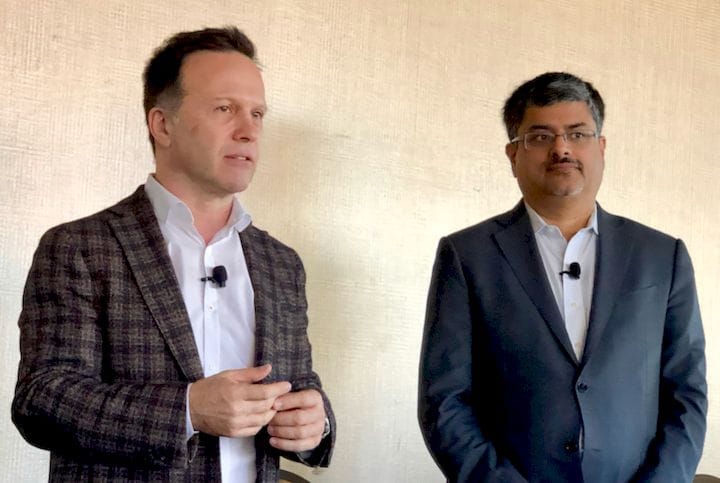![SOLIDWORKS CEO Gian Paolo Bassi and Rize CEO Andy Kalambi [Source: Fabbaloo]](https://fabbaloo.com/wp-content/uploads/2020/05/rize-solidworks-1_result_img_5eb09cb225001.jpg)
There’s something very intriguing about Dassault Systèmes’ surprise participation in a US15M investment in Rize.
Rize is a Boston-based startup offering a very powerful 3D printing option that is able to produce parts that require virtually no post-processing, are nearly isotropic and can now even be in full color. It’s also suggested they may be able to 3D print electrically conductive traces and flexible segments in the future, all through their unique combination of filament extrusion and inkjetting.
![QR code embedded into a 3D printed part by Rize [Source: Fabbaloo]](https://fabbaloo.com/wp-content/uploads/2020/05/image-asset_img_5eb09cb28b59d.jpg)
Meanwhile, Dassault Systèmes provides a wide variety of sophisticated 3D CAD/CAM and associated manufacturing functions. We’re told that they’ve never invested in a 3D printer company previously, and in fact no hardware company ever.
When corporate behavior changes in this way, it catches my interest. Why would Dassault Systèmes do this? We’ve talked with both teams, and still have some more thoughts.
There are two theories bouncing around lately.
One has it that there is simply a tight relationship between the two companies. It turns out that current Rize CEO, Andy Kalambi, a terrific fellow to discuss 3D printing with, is actually a former SOLIDWORKS exec. Kishore Boyalakuntla, their current VP of Products, also came directly from SOLIDWORKS.
Thus there are clearly personal relationships between the executives of the two companies, and some simply chalk up the deal as an outcome of that familiarity.
But I think there is a lot more to this.
Friends or not, there must be a business opportunity to be made by linking these two operations, and I have my suspicions as to what it could be.
As I experienced at the recent SOLIDWORKS World conference, it became apparent that SOLIDWORKS has a definite strategy in play. While they have long established high competency in 3D modeling, as have some other companies, they’ve extended it significantly.
The method they’re using is one that most successful companies employ: figure out what problems the customers have, and then solve them.
In the case of 3D modeling users, there were issues in how groups of designers work together, or how suppliers integrate with designers, or how designs are transferred to manufacturing departments, and so on. Each of these has been addressed by SOLIDWORKS in some way, usually by providing new function or adding a new element to their now extensive ecosystem.
But if you look at that ecosystem, the “spine” is really the trajectory of the part. Its lifecycle includes being conceived, designed, simulated, re-designed, prototyped, and eventually manufactured.
The goal seems to be to optimize this entire lifecycle from end to end. And that requires lots of databases and tracking functions as the “part” travels between lifecycle stages.
SOLIDWORKS has a pretty good handle on this throughout their ecosystem, and continues to improve it.
But what does this have to do with Rize?
There’s one thing that Rize has that no other 3D printer manufacturer does: a technology that permits embedding customized patterns into the part itself.
By using their inkjet feature, a Rize device, especially the XRIZE, can embed, say, a serial number or QR code into a part. It is not “painted” on the surface, where it could wear off. No, it is deeply embedded into the part itself, impervious to wear.
Rize has developed software to exploit this capability to specifically generate serials or codes to plant on parts as they are sequentially produced by the machine. This “auto tagging” feature is potentially very powerful, yet I suspect most companies haven’t yet realized how to make the best use of it.
Now consider how SOLIDWORKS wishes to track parts through the entire lifecycle. It could be that they see Rize’s technology as a way to extend that digital lifecycle even further: right out of the software domain and into physical reality when the part is printed!
If that sounds interesting, it may get better. During a press conference when asked about their investment, SOLIDWORKS CEO Gian Paolo Bassi mumbled something about possibly controlling the number of physical prints allowed on a design through blockchain technology, likely done through their ecosystem partner ENOVIA. This sounded quite intriguing.
I sought more information from the top ENOVIA person present at SWW2019, but when presented with the quote, they had no idea about this, as it was “above their job grade”.
So it may be that SOLIDWORKS and Rize have secret plans for developing very sophisticated methods of bringing digital capabilities right into the physical world.
Again, this is entirely speculation, but we will definitely be watching both companies closely for further developments.











No one seems to offer collaborative 3D printing modes on dual extrusion devices. We explain why this is the case.